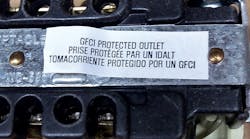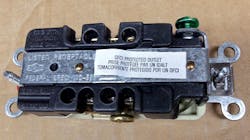All references are based on the 2014 edition of the NEC.
One of the most important lessons I’ve learned from teaching the Code — and trying to explain the meaning of the words behind a specific rule — is that sometimes you can’t take the words too literally. If you do, they just won’t make any sense. In fact, I quite often find myself needing to explain the “intended” meaning of the words rather than the “literal” presentation. This can be difficult at times because you really need to know the history behind the creation of the rule in order to understand its full intent. This is when you need to rely on the Report on Proposals, Report on Comments, interpretation from the Authority Having Jurisdiction (AHJ), and common sense. Here’s an example of what I’m talking about.
When replacing a non-grounding type receptacle on a circuit with no equipment ground wire, Sec. 406.4(D)(2)(c) permits you to replace it with a grounding-type receptacle if this new receptacle is supplied through a GFCI. This receptacle must then be marked ‘GFCI Protected” and “No Equipment Ground.” If you look at this in a literal sense, the Code requires you to mark the receptacle, not the cover plate. But as we all know, there is not a whole lot of room on the face of a receptacle for this type of marking. Where would these markings go? Perhaps we could mark the backside of the receptacle. We could install “GFCI Protected” and “No Equipment Ground” stickers on the backside of the receptacle, where receptacle users would never see them once they were installed. Marking the front of the cover plate where every user could see them, however, would be a Code violation.
But do you really think that is the intent of the Code-Making Panel? I don’t. In fact, I think it would be a really bad idea to mark the back of the receptacle rather than marking the front of the cover plate. Practically speaking, the intent is to let users of the receptacle know that this receptacle is GFCI protected, but is not connected to an equipment ground. Marking the cover plate accomplishes the intent of the Code rule. Marking the back of the receptacle does not.
So do you think it’s better to use the “literal” or the “intended” meaning of the Code? When in doubt, of course, it’s best to check with your AHJ, since it is his or her job to interpret the Code and make sure you adhere to its requirements.
There are quite a few more examples of this particular type of situation throughout the Code. We’ll explore more of these peculiarities in future editions of “Practically Speaking.”





